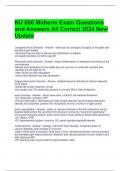NU 606 Midterm Exam Questions
and Answers All Correct 2024 New
Update
Congenital Aortic Stenosis - Answer- -valve can be unicuspid, bicuspid, or tricuspid with
partially fused leaflets
-abnormal flow can lead to fibrosis and calcification of leaflets
-pt usually develops s/s before age 30
Rheumatic aortic stenosis - Answer- -tissue inflammation r/I adhesions and fusing of the
commissures
-fibrosis and calcification of the leaflet tips can occur bc of continued turbulent flow
-develop s/s b/w ages 30-70
-often valves are also regurgitant
-mitral valve disease may also be present
Degenerative aortic stenosis - Answer- -leaflets become inflexible bc calcium deposits
at eh bases
-leaflet tips remain relatively normal
-pt's usually over 70, particularly present in pt's with DM or high cholesterol
aortic stenosis - Answer- -Aortic valve area: <0.8cm2; left ventricle thickened
-s/s: chest pain, syncope, CHF
-clinical presentation: decreased and late carotid upstroke, apical impulse displaced
laterally and sustained, positive S4, mid systolic murmur, murmur on right carotid
aortic regurgitation - Answer- -patho: a volume overload on the left ventricle bc during
diastole blood enters the ventricle from left atrium and aorta; "eccentric hypertrophy";
aortic pulse pressure widens; aortic valve doesn't close tightly so blood leaks backwards
-s/s: fatigue, SOB
-PE: hyperdynamic pulses, murmurs, S3, apical impulse displaced laterally
mitral stenosis - Answer- -etiology: rheumatic heart disease, congenital lesion or
calcium deposits, atrial masses or myxoma
-patho: mitral valve is bicuspid, valve area <1cm2, elevated pulmonary venous pressure
and elevated right-sided pressures, dilatation and reduced systolic function noted in pt's
with advanced MS
-PE: opening snap may be heard in early diastole, rales
, etiology of acute mitral regurgitation - Answer- -ruptured chord tendinae: infective
endocarditis, trauma, acute rheumatic fever, "spontaneous"
-ruptured or dysfunctional papillary muscles: ischemia, MI, trauma, myocardial abscess
-perforated leaflet: infective endocarditis, trauma
etiology of chronic mitral regurgitation - Answer- -inflammatory: rheumatic heart
disease, collagen vascular disease
-infection: infective endocarditis
-degenerative: myxomatous degeneration of the valve leaflets, calcification of mitral
annulus
-rupture or dysfunction of chordae tendineae or papillary muscle: infective endocarditis,
acute rheumatic fever, "spontaneous", ischemia, MI, myocardial abscess
-congenital: development abnormalities
mitral regurgitation - Answer- -PE: holosystolic murmur, S3, displaced or hyperdynamic
apical pulse
-Dx: transthoracic or transesophageal echocardiogram, right heart cath
congestive heart failure: pathophysiology - Answer- -result of decreased cardiac output
with increased preload and afterload
-inadequate pump function of the heart
-leads to fluid accumulation in lungs and peripheral tissues
-common end result for most cardiac disease processes
-Kerley B lines on x-ray
HFrEF - Answer- EF < 40%
Systolic HF
HFpEF - Answer- normal or increased EF
Diastolic HF
Systolic HF (HFrEF) - Answer- -decreased EF, ventricle loses contractile function and is
unable to maintain a normal EF
-can be caused by MI or exposure to cardiotoxins
-lower fraction of blood being ejected from heart
-decreased CO
Diastolic HF (HFpEF) - Answer- -ventricle has become hypertrophied
-hypertrophied ventricle has an increased forcefulness of contraction which is reflected
by increased or normal EF
-decreased CO bc hypertrophy prohibits filling of ventricle
-significant decrease in perfusion
left ventricular failure - Answer- -Pulmonary
-Clinical presentation: dyspnea, orthopnea, chest pain, nocturia, paroxysmal nocturnal
dyspnea, fatigue, confusion, hemoptysis




